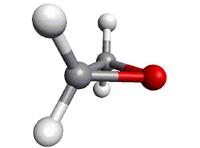Oxirane, ethylene oxide, oxa-cyclopropane; isotopolog with 13C
 | |
|---|---|
| Species tag | 045513 |
| Version | 2* |
| Date of Entry | Mar. 2022 |
| Contributor | H. S. P. Müller |
|
The very limited data set of the first entry
from July 2012 was extended significantly by
measurements between 164 and 1093 GHz
by | |
| Lines Listed | 7210 |
| Frequency / GHz | < 1500 |
| Max. J | 54 |
| log STR0 | -9.0 |
| log STR1 | -6.0 |
| Isotope Corr. | |
| Egy / (cm–1) | 0.0 |
| µa / D | 0.17 |
| µb / D | 1.89 |
| µc / D | |
| A / MHz | 25291.998 |
| B / MHz | 21597.975 |
| C / MHz | 13825.779 |
| Q(300.0) | 10103.1932 |
| Q(225.0) | 6561.1640 |
| Q(150.0) | 3571.7308 |
| Q(75.00) | 1264.1112 |
| Q(37.50) | 448.1301 |
| Q(18.75) | 159.3380 |
| Q(9.375) | 56.9864 |
| Q(5.000) | 22.6505 |
| Q(2.725) | 9.4526 |
| detected in ISM/CSM | no |